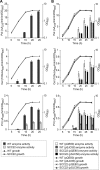DsbA plays a critical and multifaceted role in the production of secreted virulence factors by the phytopathogen Erwinia carotovora subsp. atroseptica
- PMID: 18562317
- PMCID: PMC3259793
- DOI: 10.1074/jbc.M801829200
DsbA plays a critical and multifaceted role in the production of secreted virulence factors by the phytopathogen Erwinia carotovora subsp. atroseptica
Abstract
Erwinia carotovora subsp. atroseptica is an enterobacterial phytopathogen causing economically significant soft rot disease. Pathogenesis is mediated by multiple secreted virulence factors, many of which are secreted by the type II (Out) secretion system. DsbA catalyzes the introduction of disulfide bonds into periplasmic and secreted proteins. In this study, the extracellular proteome (secretome) of wild type E. carotovora subsp. atroseptica SCRI1043, and dsbA and out mutants, was analyzed by spectral counting mass spectrometry. This revealed that dsbA inactivation had a huge impact on the secretome and identified diverse DsbA- and Out-dependent secreted proteins, representing known, predicted, and novel candidate virulence factors. Further characterization of the dsbA mutant showed that secreted enzyme activities, motility, production of the quorum-sensing signal, and virulence were absent or substantially reduced. The impact of DsbA on secreted virulence factor production was mediated at multiple levels, including impacting on the Out secretion system and the virulence gene regulatory network. Transcriptome analyses revealed that the abundance of a broad, but defined, set of transcripts, including many virulence factors, was altered in the dsbA mutant, identifying a new virulence regulon responsive to extracytoplasmic conditions. In conclusion, DsbA plays a crucial, multifaceted role in the pathogenesis of E. carotovora subsp. atroseptica.
Figures






Similar articles
-
Erwinia carotovora DsbA mutants: evidence for a periplasmic-stress signal transduction system affecting transcription of genes encoding secreted proteins.Microbiology (Reading). 1999 Aug;145 ( Pt 8):1945-1958. doi: 10.1099/13500872-145-8-1945. Microbiology (Reading). 1999. PMID: 10463161
-
Identification of a new quorum-sensing-controlled virulence factor in Erwinia carotovora subsp. atroseptica secreted via the type II targeting pathway.Mol Plant Microbe Interact. 2005 Apr;18(4):334-42. doi: 10.1094/MPMI-18-0334. Mol Plant Microbe Interact. 2005. PMID: 15828685
-
rsmC of the soft-rotting bacterium Erwinia carotovora subsp. carotovora negatively controls extracellular enzyme and harpin(Ecc) production and virulence by modulating levels of regulatory RNA (rsmB) and RNA-binding protein (RsmA).J Bacteriol. 1999 Oct;181(19):6042-52. doi: 10.1128/JB.181.19.6042-6052.1999. J Bacteriol. 1999. PMID: 10498717 Free PMC article.
-
Genome sequence of the enterobacterial phytopathogen Erwinia carotovora subsp. atroseptica and characterization of virulence factors.Proc Natl Acad Sci U S A. 2004 Jul 27;101(30):11105-10. doi: 10.1073/pnas.0402424101. Epub 2004 Jul 19. Proc Natl Acad Sci U S A. 2004. PMID: 15263089 Free PMC article.
-
Identification of the central quorum sensing regulator of virulence in the enteric phytopathogen, Erwinia carotovora: the VirR repressor.Mol Microbiol. 2006 Jan;59(1):113-25. doi: 10.1111/j.1365-2958.2005.04939.x. Mol Microbiol. 2006. PMID: 16359322
Cited by
-
Proteomic analysis of the Vibrio cholerae type II secretome reveals new proteins, including three related serine proteases.J Biol Chem. 2011 May 13;286(19):16555-66. doi: 10.1074/jbc.M110.211078. Epub 2011 Mar 8. J Biol Chem. 2011. PMID: 21385872 Free PMC article.
-
Identification of Effectors: Precipitation of Supernatant Material.Methods Mol Biol. 2024;2715:533-538. doi: 10.1007/978-1-0716-3445-5_32. Methods Mol Biol. 2024. PMID: 37930549
-
Identification of new Dickeya dadantii virulence factors secreted by the type 2 secretion system.PLoS One. 2022 Apr 13;17(4):e0265075. doi: 10.1371/journal.pone.0265075. eCollection 2022. PLoS One. 2022. PMID: 35417462 Free PMC article.
-
A high-throughput cell-based assay pipeline for the preclinical development of bacterial DsbA inhibitors as antivirulence therapeutics.Sci Rep. 2021 Jan 15;11(1):1569. doi: 10.1038/s41598-021-81007-y. Sci Rep. 2021. PMID: 33452354 Free PMC article.
-
A secreted metal-binding protein protects necrotrophic phytopathogens from reactive oxygen species.Nat Commun. 2019 Oct 24;10(1):4853. doi: 10.1038/s41467-019-12826-x. Nat Commun. 2019. PMID: 31649262 Free PMC article.
References
-
- Perombelon, M. C. M. (2002) Plant Pathol. (Oxf.) 51 1–12
-
- Toth, I. K., Bell, K. S., Holeva, M. C., and Birch, P. R. J. (2003) Mol Plant Pathol. 4 17–30 - PubMed
-
- Thomson, N. R., Thomas, J. D., and Salmond, G. P. (1999) Methods Microbiol. 29 347–426
-
- Toth, I. K., and Birch, P. R. (2005) Curr. Opin. Plant Biol. 8 424–429 - PubMed
-
- Pemberton, C. L., Whitehead, N. A., Sebaihia, M., Bell, K. S., Hyman, L. J., Harris, S. J., Matlin, A. J., Robson, N. D., Birch, P. R., Carr, J. P., Toth, I. K., and Salmond, G. P. (2005) Mol. Plant-Microbe Interact. 18 343–353 - PubMed
Publication types
MeSH terms
Substances
Associated data
- Actions
Grants and funding
LinkOut - more resources
Full Text Sources
Molecular Biology Databases

